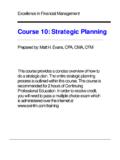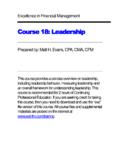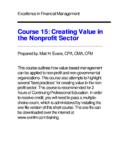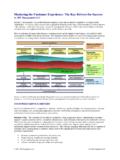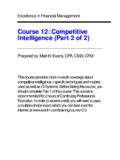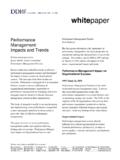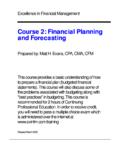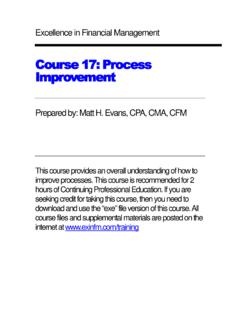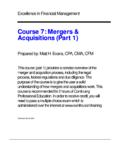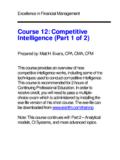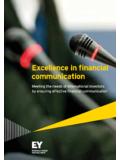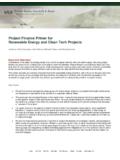Transcription of Course 6: The Management of Capital - exinfm
1 Course 6: The Management of Course 6: The Management of CapitalCapital Prepared by: Matt H. Evans, CPA, CMA, CFM This Course provides an overview of concepts related to the Management of Capital . This Course is recommended for 2 hours of Continuing Professional Education. In order to receive credit, you will need to pass a multiple-choice exam which is administered by installing the exe file version of this short Course . The exe file can be downloaded over the internet, Excellence in Financial Management Basic Concepts and Theories Introduction The long-term investments we make today will determine the value of our business tomorrow. In order to make long-term investments in new product lines, new equipment and other assets, managers must know the cost of obtaining funds to acquire these assets. The cost associated with different sources of funds is called the cost of Capital .
2 Cost of Capital represents the rate a business must pay for each source of funds - debt, preferred stock, common stock, and retained earnings. Since we want to maintain existing market values, cost of Capital is the minimum acceptable rate of return for long-term investments. If the business earns more than its cost of Capital , the market value of the business will increase. Likewise, if returns on long-term investments are below the cost of Capital , market values will decline. This leads us to a very fundamental objective within financial Management - maximizing values for the owners of the business. Therefore, how we manage Capital is extremely important to fulfilling the basic objective of increased shareholder value. The Economics of Capital An understanding of economics and Capital can also help us understand how we should manage Capital within an organization.
3 For example, the total amount of Capital available is determined by the total amount of investment. The overall economy has a total Capital equal to the sum of all Capital goods (assets). Since these goods lose value over time, some level of reinvestment is needed to maintain the asset base at its current size. Additional investments will cause the Capital stock of an economy to grow, similar to the assets of a business. The amount invested in the economy is determined by the after tax rate of return on Capital . The actual level of investment depends on the willingness of people to invest in assets. People invest based on the returns they expect to receive. The returns to investors must be adjusted for inflation, taxes, depreciation, and risk related to the investment. It is the after tax real rate of return that drives investment.
4 Overall, the after tax rate will remain constant over time due to changes in investment spending. For example, if the rate of return on Capital were to increase, there will be an increase in investment spending. As the Capital stock expands from increased investing, the rate of return on Capital will drop back down. Conversely, when the rate of return on Capital is low, there will be a decrease in investment. As Capital shrinks, the rate of return on Capital rises. Consequently, investment spending will keep rates of return on Capital at stable levels. Chapter 1 2 Taxation of Capital will increase the cost of Capital . In order to supply Capital , investors must receive a minimum after tax real rate of return. The users of Capital not only pay investors a nominal rate of return, but they also incur the cost of economic depreciation (lost values of Capital assets) and related taxes on Capital .
5 These total costs represent the cost of Capital . Basic Considerations in Managing Capital Now that we understand the importance of Capital , let's focus on how we manage Capital within an organization. The overall objective is to find an "optimal" Capital structure - the right mix of Capital sources (debt and equity) that minimizes the overall cost of Capital and maximizes values to the shareholders (owners of the business). When we raise Capital , we have two choices - issue debt or issue stock. Debt is represented by bonds which are long-term instruments sold to investors. Stock is the ownership interest of the business and depending upon the rules of incorporation, stockholders will have certain rights. Therefore, we start our understanding of Capital Management by looking at the advantages and disadvantages of the two sources of Capital : Some advantages to using stock are: No fixed payments are required to investors; dividends are paid only as earnings are available.
6 No maturity date on the security, the invested Capital does not have to be repaid. Improves the credit worthiness of the company. Some disadvantages to using stock are: Dilutes the earnings per share to shareholders. Issuance costs are higher than debt. Issuing more stock can increase the overall cost of Capital . Dividend payments to shareholders are not tax deductible. Some advantages to using debt are: Interest payments are tax deductible. Does not dilute earnings per share or control within the company. Cost is fixed; interest and principal do not change. Expected returns to investors are usually lower than stock. Some disadvantages to using debt are: Fixed charges must be paid regardless of available earnings or cash flow. 3 Adds more risk to the business. Has a maturity date and the Capital invested must be repaid to investors. In addition to understanding the pros and cons of financial securities, we also need to recognize that several conditions will impact how we raise Capital .
7 These conditions include: Economic Conditions: The demand and supply of Capital in the marketplace can impact how Capital is raised. For example, expectations of inflation will influence the cost that is paid for Capital . Higher rates of inflation erode the values of investments and thus, investors will demand higher rates of return. Market Conditions: The demand for higher rates of return will increase the cost of Capital . For example, if we raise Capital with a security that is not highly marketable, investors will require higher rates of return for the increased risk. Operating Conditions: The level of fixed costs used to operate the business needs to be considered. For example, higher fixed costs can result in wider variations to operating income from numerous factors - increased competition, slower economic growth, etc. This is referred to as business risk.
8 Financial Conditions: The existing levels of outstanding debt will impact how Capital will be raised. Higher levels of debt (including preferred stock) can result in wider variations to earnings due to higher fixed obligations that must be paid (interest to debt holders and fixed dividends to preferred stock holders). This is referred to as financial risk. Not only do we need to look at various conditions, but we need to consider how financing will impact Capital structure. Capital structure appears on the right side of the Balance Sheet as liabilities and equity; the long-term sources of funds to finance assets. Assets appear on the left side of the Balance Sheet. Capital structure is the permanent financing of the business through the use debt and stock. The total of all liabilities and equity is referred to as Financial Structure.
9 Therefore, Capital Structure = Financial Structure - Current Liabilities. Finding the right Capital structure encompasses numerous considerations - growth rates in sales, risk attitudes of Management , liquidity of assets, control position of the company, etc. Finding the right Capital structure also involves finding the right amount of financial leverage. Financial leverage is the financing of assets with fixed obligations - debt and preferred stock. The use of financial leverage increases return on equity up to a certain level of operating income. As you use more financial leverage (debt and preferred stock), higher levels of operating income are needed to cover the additional fixed obligations (interest on debt and fixed dividends on preferred stock). Generally, the use of financial leverage will improve financial performance whenever returns are higher than the costs of obtaining funds.
10 In a perfect world, Management would favor more leverage whenever return on Capital exceeds the after tax costs of debt. However, higher returns also result in higher risk to the business (risk return tradeoff). Therefore, the use of financial leverage is a balancing act between higher returns for shareholders vs. higher risk to shareholders. Financial leverage can be measured with ratios such as debt to total assets. Financial leverage is also expressed as the Degree of Financial Leverage or DFL. DFL is the 4 percentage change in earnings given a change in operating income (Earnings Before Interest & Taxes or EBIT). The higher the DFL, the riskier the business. We can use the following formula to calculate DFL: DFL = EBIT / EBIT - I - (P / (1-TR)) where I is Interest and P is Preferred Dividends and TR is the tax rate.
